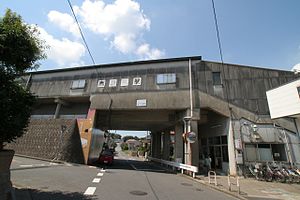LAF3
LAF3LA3는 운동 기능에 영향을 미치는 장애를 가진 스포츠 선수를 위한 휠체어 스포츠 분류이다.이 반의 사람들은 정상적인 몸통 기능, 좋은 앉은뱅이 균형, 그리고 기능적인 상지를 가지고 있다.그들은 하반신을 제한적으로 사용한다.
국제적으로 이 스포츠의 거버넌스는 2005년 ISMSF와 ISOD의 합병에 따라 IWAS에 의해 처리된다.분류는 관련 국가 기관에 의해 전국적으로 처리된다.이 클래스에 속한 사람들이 이용할 수 있는 스포츠는 양궁, 육상, 승마를 포함한다.
정의.
LAF3는 Les Autres 스포츠 [1][2]분류입니다.이 클래스의 스포츠인들은 근육 기능의 감소의 결과로 정기적으로 휠체어를 사용한다.그들은 정상적인 몸통 기능, 균형 그리고 [2]상지의 사용을 가지고 있다.의학적으로 반신마비증(hemiparesis)과 한쪽 팔에 변형이 있는 고관절 및 무릎 경직이 있는 사람이 이 세분류에 해당한다.적어도 두 다리의 기능이 제한적이라는 뜻입니다.기능 분류 측면에서 이는 운동선수가 휠체어를 사용하고, 앉은 자세 균형이 좋으며, [3]팔 기능이 좋다는 것을 의미한다.1984년 하계 패럴림픽에서 LAF3는 올림픽 주최측에 의해 "정상적인 팔 기능과 좋은 [4]앉은자리로 묶인 휠체어"로 정의되었다.
거버넌스
레스 아우트레스 스포츠 분류는 원래 만들어졌고 국제장애인스포츠기구(ISOD)[5][6][7][8]가 통제하고 있다.현재 분류는 2005년 ISMSF와 ISOD의 [11][12]합병 이후 이 역할을 이어받아 [9][10]IWAS에 의해 감독되고 있습니다.
국가 스포츠 기관은 국가 차원에서 분류를 처리합니다.영국에서는, 이것은 영국 장애인 스포츠 협회와 레스 스포츠 [13][14][15]협회입니다.미국에서는, 이것은 미국 레즈 오토레스 스포츠 [16]협회입니다.미국에서 사용되는 분류 시스템은 일반적으로 국제 표준과 일치하지만, 육상에서는 5개의 휠체어 클래스와 5개의 레스 오토레스 스포츠 [17]피플을 위한 보행 클래스가 있었다.호주에서는 장애인 스포츠 호주 호주 스포츠 기구의 장애인(ASOD), 뇌 중풍 호주 체육 레크리에이션 연맹(CPASRF)과 휠체어 스포츠 Aust의 2003년 합병 이후 역할에 레 Autres sportspeople,[18]에 분류를 위해, 휠체어 스포츠 오스트레일리아는 관리하는 단체이다.ra리아(WSA)[19]
스포츠
육상 경기
육상에서는 LAF3 선수들이 F54, F55, F56, F57, F58 종목에 출전한다.휠체어 운동 [1][2][20]교실입니다.이 클래스의 선수들은 던지는 팔에 정상적인 기능을 가지고 있다.던지는 동안,[2] 그들은 일반적으로 좋은 균형을 유지할 수 있다.이 클래스의 선수들도 T44에서 경쟁할 수 있다.한쪽 다리 근육이 약하거나 관절에 [1]제약이 있는 분들을 위한 스탠딩 클래스입니다.1984년 하계 패럴림픽에서 LAF1, LAF2, LAF3 육상 선수들은 [4]60m와 400m의 거리를 달렸다.1984년 하계 [4]패럴림픽에는 이 반에 다양한 장애를 가진 다양한 스포츠 선수들이 있었다.
기타 스포츠
이 반에서 이용 가능한 스포츠 중 하나는 양궁이다.LAF3 분류 선수들은 ARW2에 [21][22]출전한다.레스 오트레스 선수들도 앉아서 하는 배구에 참여할 수 있다.과거에, 그 스포츠는 분류 시스템이 있었고 그들은 이 클래스들 중 하나에 배정되었다.이 규칙은 나중에 레스 아우트레스 선수를 포함하여 최소 [23][24]장애 요건을 충족하는 모든 사람을 포함하도록 변경되었습니다.파워리프팅은 최소한의 장애요건만으로 다른 사람과 경쟁하고 [24][25]체중에 따라 구분되는 또 다른 스포츠입니다.패러 승마도 또 다른 옵션이다.휠체어 사용자이기 때문에 LAF3 탑승자는 1등급일 수 있습니다.이 등급은 일반적으로 심각한 수준의 [21]장애를 가진 뇌성마비, 레즈 오토레스 및 척수 손상을 가진 사람들을 대상으로 합니다.
레퍼런스
- ^ a b c "CLASSIFICATION SYSTEM FOR STUDENTS WITH A DISABILITY". Queensland Sport. Queensland Sport. Archived from the original on April 4, 2015. Retrieved July 23, 2016.
- ^ a b c d Consejo Superior de Deportes (2011). Deportistas sin Adjectivos (PDF) (in European Spanish). Spain: Consejo Superior de Deportes. Archived from the original (PDF) on 2016-11-04. Retrieved 2016-07-28.
- ^ MD, Michael A. Alexander; MD, Dennis J. Matthews (2009-09-18). Pediatric Rehabilitation: Principles & Practices, Fourth Edition. Demos Medical Publishing. ISBN 9781935281658.
- ^ a b c Broekhoff, Jan (1986-06-01). The 1984 Olympic Scientific Congress proceedings: Eugene, Ore., 19-26 July 1984 : (also: OSC proceedings). Human Kinetics Publishers. ISBN 9780873220064.
- ^ "ritgerd". www.ifsport.is (in Icelandic). Archived from the original on 2016-05-05. Retrieved 2016-07-30.
- ^ Richter, Kenneth J.; Adams-Mushett, Carol; Ferrara, Michael S.; McCann, B. Cairbre (1992). "lntegrated Swimming Classification : A Faulted System" (PDF). Adapted Physical Activity Quarterly. 9: 5–13. doi:10.1123/apaq.9.1.5. Retrieved August 1, 2016.
- ^ Rehabilitation World. Rehabilitation International USA. 1984-01-01.
- ^ Shephard, Roy J. (1990-01-01). Fitness in special populations. Human Kinetics Books. ISBN 9780873222709.
- ^ "About IWAS". Int'l Wheelchair & Amputee Sports Federation. Int'l Wheelchair & Amputee Sports Federation. Retrieved 2016-07-30.
- ^ "Other Sports". Int'l Wheelchair & Amputee Sports Federation. Int'l Wheelchair & Amputee Sports Federation. Retrieved 2016-07-30.
- ^ KOCCA (2011). "장애인e스포츠 활성화를 위한 스포츠 등급분류 연구" [Activate e-sports for people with disabilities: Sports Classification Study] (PDF). KOCCA (in Korean). Archived from the original (PDF) on 2016-08-17.
- ^ Andrews, David L.; Carrington, Ben (2013-06-21). A Companion to Sport. John Wiley & Sons. ISBN 9781118325285.
- ^ DePauw, Karen P.; Gavron, Susan J. (2005-01-01). Disability Sport. Human Kinetics. ISBN 9780736046381.
- ^ Thomas, Nigel (2002). "Sport and Disability" (PDF). pp. 105–124. Retrieved August 1, 2016.
- ^ Vickerman, Philip (2007-01-24). Teaching Physical Education to Children with Special Educational Needs. Routledge. ISBN 9781134168460.
- ^ McKeag, Douglas; Moeller, James L. (2007-01-01). ACSM's Primary Care Sports Medicine. Lippincott Williams & Wilkins. ISBN 9780781770286.
- ^ Winnick, Joseph P. (2011-01-01). Adapted Physical Education and Sport. Human Kinetics. ISBN 9780736089180.
- ^ Houbolt, Mirjam; Denman, Karen (1998-01-01). Coaching Athletes with Cerebral Palsy. Australian Sports Commission. ISBN 9780642263445.
- ^ "About DSA". Disability Sports Australia. Retrieved 2016-08-01.
- ^ International Paralympic Committee (June 2009). "IPC Athletics Classification Project for Physical Impairments: Final Report - Stage 1" (PDF). International Paralympic Committee Governing Committee Reports.
- ^ a b "Paralympics: What Do The Categories Mean?". Leading Britain's Conversation. Leading Britain's Conversation. Retrieved 2016-07-28.
- ^ "Paralympic Archery - overview, rules and classification British Paralympic Association". British Paralympic Association. Archived from the original on 2016-07-24. Retrieved 2016-07-31.
- ^ "Paralympics categories explained". ABC News. 2008-09-03. Retrieved 2016-07-31.
- ^ a b Davis, Ronald W. (2011-01-01). Teaching Disability Sport: A Guide for Physical Educators. Human Kinetics. ISBN 9780736082587.
- ^ Consejo Superior de Deportes (2011). Deportistas sin Adjectivos (PDF) (in European Spanish). Spain: Consejo Superior de Deportes. Archived from the original (PDF) on 2016-11-04. Retrieved 2016-07-28.


